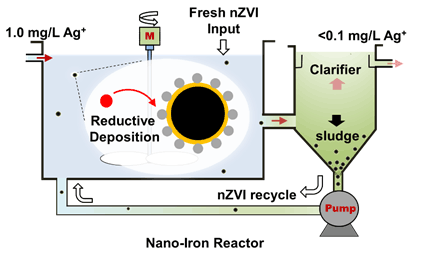| [1] Yu, S. L.; Yin, Y. G.; Liu, J. F. Environ. Sci.-Proc. Imp. 2013, 15, 78.
[2] Syed, S. Waste. Manage. 2016, 50, 234.
[3] World Silver Survey, 2017, GFMS Limited/The Silver Institute. http://www.silverinstitute.org
[4] Benn, M. T.; Westerhoff, P. Environ. Sci. Technol. 2008, 42, 4133.
[5] Zhou, X. X.; Liu, J. F.; Yuan, C. G.; Chen, Y. S. J. Anal. Atom. Spectrom. 2016, 31, 2285.
[6] Eckelman, M. J.; Graedel, T. E. Environ. Sci. Technol. 2007, 41, 6283.
[7] Li, R.; Lu, Y. Y.; Lei, K. X.; Li, F. J.; Cheng, F. Y.; Chen, J. Acta Chim. Sinica 2017, 75, 199(in Chinese). (李冉, 卢艳莹, 雷凯翔, 李福军, 程方益, 陈军, 化学学报, 2017, 75, 199.)
[8] Wang, C.; Deng, N.; Wang, L. L.; Xu, D. J.; Yao, X. Q. Chinese J. Org. Chem. 2016, 36, 1034(in Chinese). (王超, 邓楠, 王玲玲, 许定健, 姚小泉, 有机化学, 2016, 36, 1034.)
[9] Vance, M. E.; Kuiken, T.; Vejerano, E. P.; McGinnis, S. P.; Hochella, M. F.; Rejeski, D.; Hull, M. S. Beilstein. J. Nanotech. 2015, 6, 1769.
[10] Song, X. H.; Gunawan, P.; Jiang, R. R.; Leong, S. S. J.; Wang, K.; Xu, R. J. Hazard. Mater. 2011, 194, 162.
[11] Zhou, Y. M.; Gao, B.; Zimmerman, R. A.; Cao, X. D. Chemosphere 2014, 117, 801.
[12] Celik. Z.; Gulfen. M.; Aydin, A. O. J. Hazard. Mater. 2010, 174, 556.
[13] Wang, H. Y.; Gao, H.; Sun, J. S.; Li, J.; Su, Y. X.; Ji, Y. L.; Gong, C. M. Desalination 2011, 270, 258.
[14] Huo, H. Y.; Su, H. J.; Tan, T. W. Chem. Eng. J. 2009, 150, 139.
[15] Huang, X. Y.; Wang, W.; Ling, L.; Zhang, W. X. Acta Chim. Sinica 2017, 75, 529(in Chinese). (黄潇月, 王伟, 凌岚, 张伟贤, 化学学报, 2017, 75, 529.)
[16] Mu, Y.; Jia, F. L.; Ai, Z. H.; Zhang, L. Z. Environ. Sci.-Nano 2017, 4, 27.
[17] Fu, F. L.; Dionysiou, D. D.; Liu, H. J. Hazard. Mater. 2014, 267, 194.
[18] Zhang, Y. L.; Yan, J.; Dai, C. M.; Li, Y. T.; Zhou, Y.; Zhou, X. F. J. Nanopart. Res. 2015, 17, 1110.
[19] Teng, W.; Fan, J. W.; Wang, W.; Bai, N.; Liu, R.; Liu, Y.; Deng, Y. H.; Kong, B.; Yang, J. P.; Zhao, D. Y.; Zhang, W. X. J. Mater. Chem. A 2017, 5, 4478.
[20] Ling, L.; Zhang, W. X. J. Am. Chem. Soc. 2015, 137, 2788.
[21] Sheng, G. D.; Yang, P. J.; Tang, Y. N.; Hu, Q. Y.; Li, H.; Ren, X. M.; Hu, B. W.; Wang, X. K.; Huang, Y. Y. Appl. Catal. B-Environ. 2016, 193, 189.
[22] Xia, X. F.; Hua, Y. L.; Huang, X. Y.; Ling, L.; Zhang, W. X. Acta Chim. Sinica 2017, 75, 594(in Chinese). (夏雪芬, 滑熠龙, 黄潇月, 凌岚, 张伟贤, 化学学报, 2017, 75, 594.)
[23] Sheng, G. D.; Alsaedi, A.; Shammakh, W.; Monaquel, S.; Sheng, J.; Wang, X. K.; Li, H.; Huang, Y. Y. Appl. Carbon. 2016, 99, 123.
[24] Li, S. L.; Wang, W.; Liu, Y. Y.; Zhang, W. X. Chem. Eng. J. 2014, 254, 115.
[25] Wang, W.; Hua, Y. L.; Li, S. L.; Yan, W. L.; Zhang, W. X. Chem. Eng. J. 2016, 304, 79.
[26] Li, S. L.; Wang, W.; Liang, F. P.; Zhang, W. X. J. Hazard. Mater. 2017, 322, 163.
[27] Wang, W.; Li, S. L.; Lei, H.; Pan, B. C.; Zhang, W. X. Chem. Eng. J. 2015, 260, 616.
[28] Shi, Z. Q.; Nurmi, T. J.; Tratnyek, G. P. Environ. Sci. Technol. 2011, 45, 1586.
[29] Sverdrup, H.; Koca, D.; Ragnarsdottir, V. K. Resour. Conserv. Recy. 2014, 83, 121.
[30] Liang, L. P.; Yang, W. J.; Guan, X. H.; Li, J. L.; Xu, Z. J.; Wu, J.; Huang, Y. Y.; Zhang, X. Z. Water Res. 2013, 47, 5846.
[31] Guan, X. H.; Sun, Y. K.; Qin, H. J.; Li, J. X.; Lo, I. M. C.; He, D.; Dong, H. R. Water Res. 2015, 75, 224.
[32] Liang, L. P.; Sun, W.; Guan, X. H.; Huang, Y. Y.; Choi, W. Y.; Bao, H. L.; Li, L. N.; Jiang, Z. Water Res. 2014, 49, 371.
[33] Nitayaphat, W.; Jintakosol, T. J. Clean. Prod. 2015, 87, 850.
[34] Wang, Y.; Ma, X. J.; Li, Y. F.; Li, X. L.; Yang, L. Q.; Ji, L.; He, Y. Chem. Eng. J. 2012, 209, 394.
[35] Ju, S. H.; Zhang, Y. F.; Zhang, Y.; Xue, P. Y.; Wang, Y. H. J. Hazard. Mater. 2011, 192, 554.
[36] Yin, Y. G.; Shen, M. H.; Tan, Z. Q.; Yu, S. J.; Liu, J. F.; Jiang, G. B. Environ. Sci. Technol. 2015, 49, 6581. |
